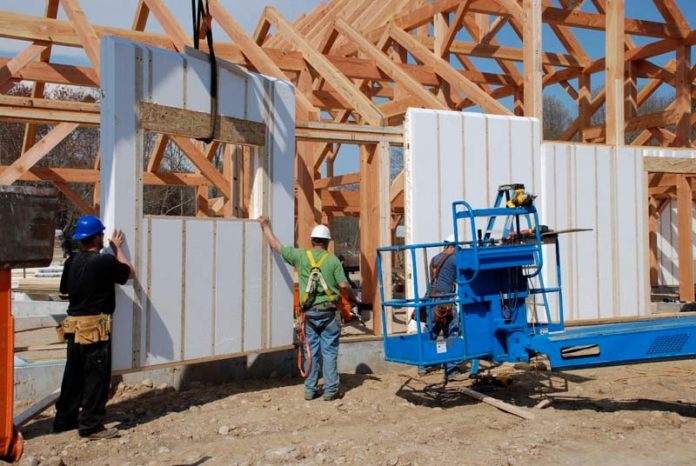
When it comes to green building, structural insulated panels, or SIPs as they are called in the industry, are used for walls and ceilings. However, their increasing use make them part of the foundation for reducing energy costs.
As the movement toward green building and sustainable development slowly gains momentum, contractors are increasingly using SIPs as an easy means to reduce energy costs. In Rhode Island, manufacturers are beginning to see an improvement in the market.
SIPs consist of expanded polystyrene, high-performance, rigid insulation, usually with an engineered wood facing, called oriented-strand board, adhered to each interior and exterior side. It has structural components that give the panel strength. They are also known for deterring air infiltration, reducing drafts and giving a tight air seal. Because very little conventional framing is involved, SIPs can also save labor costs.
Each SIP manufacturer fabricates the panels with their own distinct touches, so the panels can have different features; however, the end product is the same.
Conventional walls are designed to be structural, with insulation not considered. With SIPs, the insulation is not an afterthought but an integral part of the system. The insulation is solid, so there is no air movement within the wall, nor are there studs acting as thermal breaks, conduits that reduce energy efficiency.
A standard 2-by-4-inch, stick-framed wall has an insulation rating of R-11 between the studs, but the studs may comprise up to 20 percent of the wall area, thus its actual performance is closer to R-9. A 4.5” urethane panel generally has an R-value of 25.
One proponent of their usage is Oyster Works of Charlestown, an architectural and project-management firm specializing in designing and building green projects. Over the last four years they have constructed or rehabilitated commercial and residential buildings using SIPs, and have several more plans in development.
Those projects include dwellings in South County, Charlestown Wine & Spirits and the upcoming ChurchWoods affordable housing project in Charlestown.
“If the installation quality and attention to detail isn’t good, you’re going to have problems. Poor installation leads to problems with the building envelope and with moisture,” said Andrew Baer, project manager and partner at Oyster Works. “Properly installed, they are a very good way to maintain a highly effective building envelope.”
William Kite Architects of Providence has also used SIPs in a variety of commercial and residential applications.
“They are both the structural and insulation system,” said Christine Malecki West, a principal at the company. “They perform well for energy savings as well as material efficiency.” West agrees with their performance but has also observed that conventional construction methods, when done correctly with care and the right materials, can achieve the same savings. “A contractor and his forces must be well-trained and do quality construction, like sealing all the joints; it requires care.”
Many contractors still prefer conventional, or “stick-built,” construction because they are familiar with its methods. “There is a learning curve [for SIPs] and once you figure them out it moves very quickly, but there is a little fear of innovation out there in the industry,” West said.
“They can save money and time on construction but can also be more difficult to change in the field. They can also increase the amount of time in the design phase,” she said. She also stated that the roofing panels are very economical, providing a tight seal and quickness of construction.
In Smithfield, Branch River Plastics has manufactured structural insulated panels for over 25 years. “We are green,” said Greg Kelleher, general manager at the company. “We’ve been green since before they started calling it ‘green.’ We’ve been making panels here since the mid-1980s.” Since 1978, the company has manufactured a variety of expanded polystyrene products for residential and commercial use.
Their “R-Control” SIPs are one-piece, structural systems that can use engineered wood facings on each face to provide easy application of exterior shingles or interior drywall. Panels are available in 4-foot-by-8-foot sizes to 8 feet by 24 feet. Standard panels come in thicknesses from 4.5 inches to 12.25 inches, depending on the insulation requirements.
As with many SIPs, openings for windows and doors can be built right into the panel at the factory, or cut in during field construction. Boundary framing is then installed and the window or door is conventionally set.
“We just had one of our best first quarters in a while,” Kelleher said. “First of all, it was good because of the weather; [those in the construction industry] were able to work. I can’t say that the housing market is turning around, but there have been some good things happening lately; it’s getting better.”
The Lightship Group in North Kingstown has been in the marine-repair business since 1983, and its SIP construction company, Delta H, has fabricated panels since 2008. Their product, “climate block,” does not contain interior studs that touch both outside and inside walls, causing a thermal bridge, or short circuit. “We focused on the building envelope because that’s where [green building] starts,” said Thomas Alexander, president of both companies. “The most immediate savings is to use the proper envelope.
“Ideally, a stick design that converts to our system will allow us to fabricate everything in the shop to have everything made as precisely as possible so that everything clicks together in the field,” Alexander said. •












